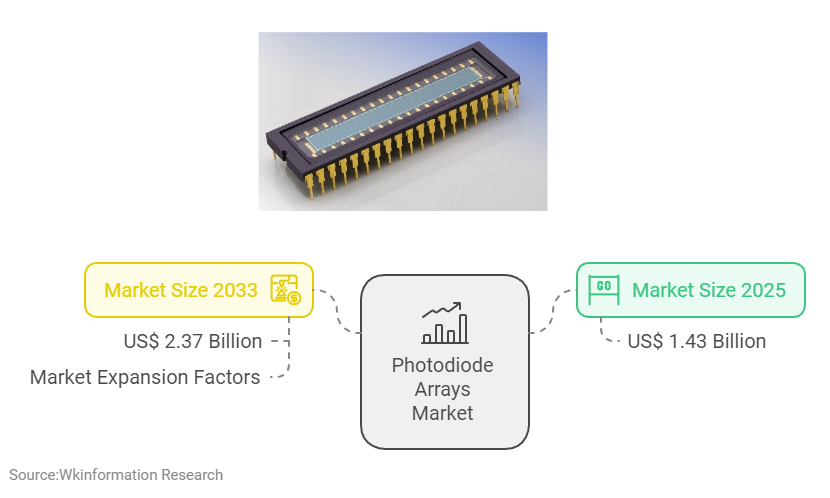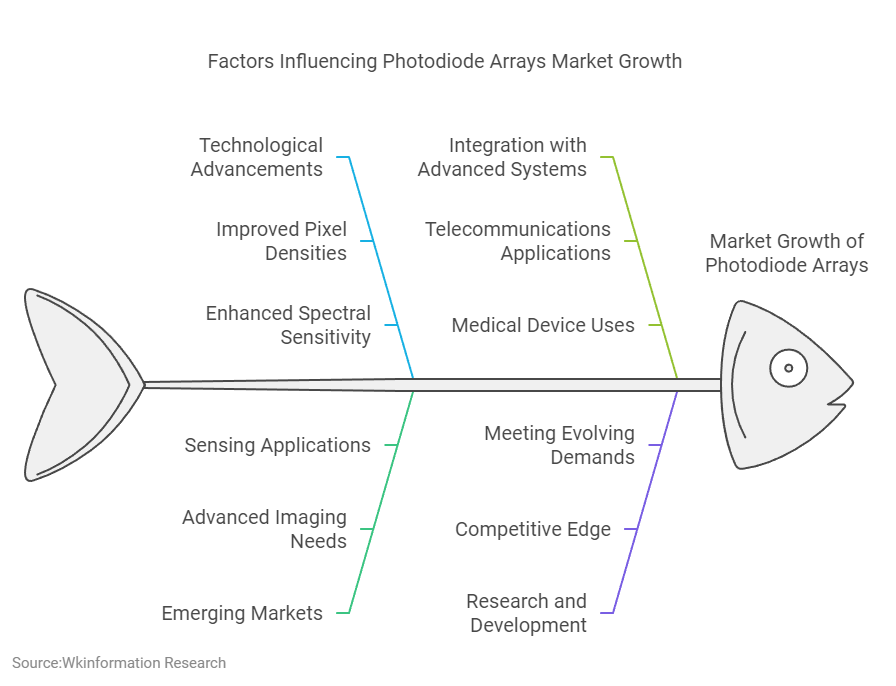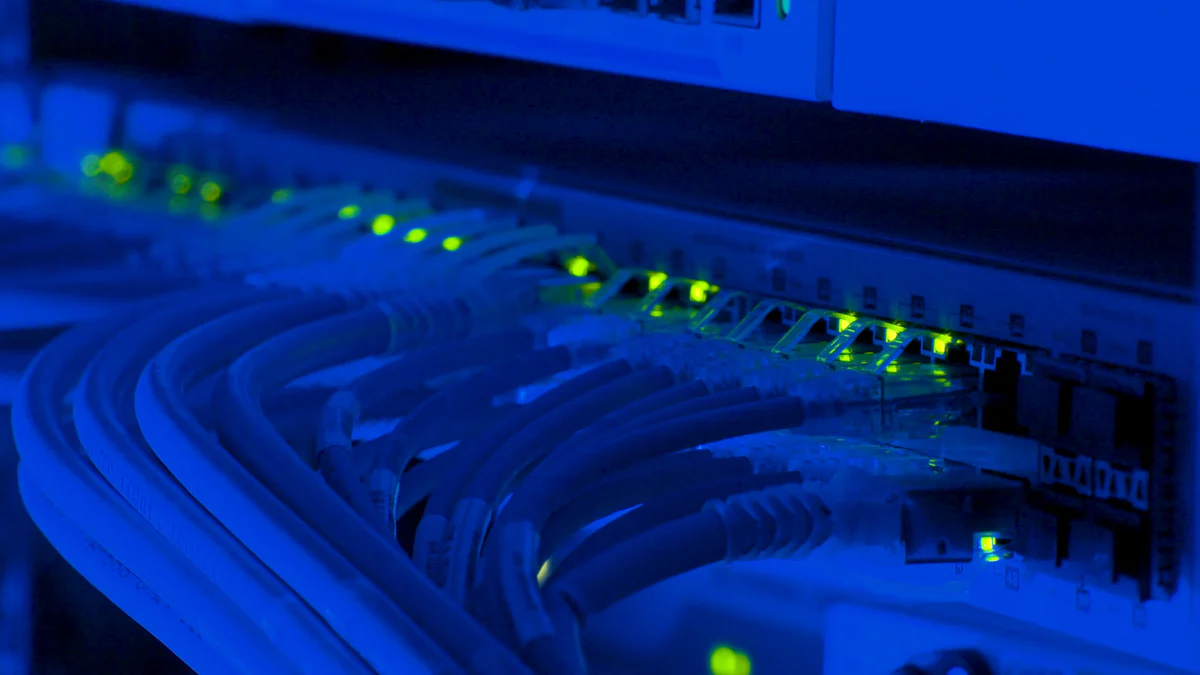
The photodiode arrays market is experiencing remarkable growth, driven by technological advancements and diverse applications. In 2025, the market size reached approximately US$ 1.43 Billion. Analysts project it will expand to US$ 2.37 Billion by 2033.In particular, the InGaAs photodiode arrays market is expanding rapidly, fueled by its use in consumer electronics like cameras and sensors. Recent trends highlight significant improvements in pixel densities and spectral sensitivity, enhancing the performance of photodiode arrays. This dynamic market continues to evolve, offering promising opportunities for innovation and development.
Key Takeaways
- The photodiode arrays market is projected to reach around $1.43 billion by 2025, driven by technological advancements and diverse applications.
- InGaAs photodiode arrays are rapidly growing in popularity, particularly in consumer electronics, due to their superior performance in low-light conditions.
- Technological innovations, such as improved pixel densities and spectral sensitivity, are enhancing the efficiency and capabilities of photodiode arrays.
- Emerging markets present significant opportunities for growth, as industries seek advanced photodiode solutions for imaging and sensing applications.
- The integration of photodiodes with advanced imaging systems is expanding their applications across telecommunications and medical devices.
- Investing in research and development is crucial for companies to stay competitive and meet the evolving demands of the photodiode arrays market.
- Understanding regional dynamics, particularly in Asia-Pacific, North America, and Europe, is essential for businesses looking to capitalize on market growth.

Market Overview
Market Size and Growth
Recent Statistics
The photodiode arrays market has shown impressive growth in recent years. The market size has expanded significantly, driven by technological advancements and increasing demand across various sectors. The InGaAs photodiode arrays market, in particular, has seen remarkable growth due to its unique capabilities and diverse applications. Recent statistics indicate that the global photodiode arrays market is on a positive trajectory, with substantial increases in market size observed annually.
Projections for Future Growth
Looking ahead, the photodiode arrays market is poised for continued expansion. Analysts project that the market size will reach new heights, with a compound annual growth rate (CAGR) that reflects strong market growth. The InGaAs photodiode arrays market is expected to play a pivotal role in this growth, with projections indicating a significant increase in market size by 2030. This growth is fueled by ongoing innovations in photodiode technology and the integration of photodiodes into emerging applications.
Key Market Segments
Segmentation by Application
The photodiode arrays market is segmented by application, with each segment contributing to the overall market size. Key applications include consumer electronics, medical devices, and telecommunications. The InGaAs photodiode arrays market, in particular, has found extensive use in consumer electronics, enhancing the performance of cameras and sensors. This segmentation highlights the diverse applications of photodiodes and their impact on market growth.
Segmentation by Region
Regional dynamics play a crucial role in the photodiode arrays market. North America, Asia-Pacific, and Europe are major players, each with distinct market characteristics. The InGaAs photodiode arrays market has seen significant growth in Asia-Pacific, driven by technological advancements and increasing demand. North America and Europe also contribute substantially to the market size, with growth trends reflecting regional preferences and technological adoption. The market’s regional segmentation underscores the global nature of the photodiode arrays market and its potential for further expansion.
Key Trends in the Photodiode Arrays Market

Technological Innovations
Advances in Photodiode Technology
The photodiode arrays market has witnessed remarkable technological advancements. These innovations have revolutionized the field of optoelectronics, enhancing the performance and efficiency of photodiodes. Recent developments have focused on improving pixel densities and spectral sensitivity, which are crucial for applications in imaging and sensing. The InGaAs photodiode arrays market, in particular, has benefited from these advancements, offering superior capabilities in converting light energy into electrical signals. This progress has significantly contributed to the growth and size of the photodiode arrays market.
Integration with Other Technologies
Integration with other technologies has become a key trend in the photodiode arrays market. Photodiodes are increasingly being combined with advanced imaging systems and sensors, expanding their applications across various industries. This integration enhances the functionality of photodiode arrays, making them indispensable in fields such as telecommunications and medical imaging. The InGaAs photodiode arrays market has seen substantial growth due to this trend, as these arrays are now vital components in cutting-edge technologies.
Increasing Applications
Use in Consumer Electronics
Consumer electronics represent a significant segment of the photodiode arrays market. The demand for high-performance cameras and sensors has driven the growth of the InGaAs photodiode arrays market. These photodiodes offer exceptional performance in low-light conditions, making them ideal for use in smartphones and digital cameras. As consumer preferences evolve, the applications drive demand for more advanced photodiode arrays, contributing to the overall market growth and size.
Expansion in Medical Devices
The expansion of photodiode arrays in medical devices marks another important trend. These arrays play a crucial role in medical imaging and diagnostics, providing accurate and reliable data. The InGaAs photodiode arrays market has experienced significant growth in this sector, as these photodiodes offer precise measurements and enhanced sensitivity. The increasing adoption of photodiode arrays in medical devices underscores their importance in improving healthcare outcomes.
Regional Market Dynamics
Growth in Asia-Pacific
Asia-Pacific has emerged as a key player in the photodiode arrays market. The region’s rapid technological advancements and increasing demand for advanced imaging solutions have fueled market growth. The InGaAs photodiode arrays market, in particular, has seen substantial growth in Asia-Pacific, driven by the region’s focus on innovation and development. This growth highlights the region’s potential to lead the global photodiode arrays market.
Trends in North America and Europe
North America and Europe continue to play significant roles in the photodiode arrays market. These regions have shown steady growth, driven by the adoption of advanced technologies and the demand for high-performance photodiodes. The InGaAs photodiode arrays market has gained traction in these regions, reflecting the growing interest in cutting-edge applications. The trends in North America and Europe underscore the global nature of the photodiode arrays market and its potential for further expansion.
Market Share Analysis
Leading Companies
Market Leaders
The photodiode arrays market features several prominent companies that lead in innovation and product offerings. Hamamatsu Photonics stands out with its extensive product portfolio and strong focus on research and development. The company consistently delivers high-quality photodiodes, contributing significantly to the market’s size and growth. Excelitas Technologies Corp. also plays a crucial role, providing advanced photodiode arrays for defense, aerospace, and industrial applications. Their emphasis on innovation ensures high-performance solutions for customers.
OSI Optoelectronics is another key player known for its expertise in optoelectronic components. The company offers a broad range of InGaAs photodiode arrays, focusing on continuous product development and strategic collaborations. Teledyne Judson Technologies excels in providing high-quality infrared detectors and imaging solutions, particularly in the InGaAs photodiode arrays market. Their products serve critical sectors such as defense, telecommunications, and medical fields.
Emerging Players
Emerging players in the photodiode arrays market are making significant strides. First Sensor AG is renowned for its innovative solutions and high-quality photodiodes. The company’s focus on technological innovation and strategic partnerships has established a strong market presence. Luna Innovations Incorporated is recognized for its advanced photodiode technologies and robust R&D capabilities, developing high-performance photodiodes for specialized applications like aerospace and defense.
Laser Components provides a wide range of photodiode arrays and other optoelectronic components. Their commitment to innovation and product development meets the evolving needs of customers. Detection Technology is also at the forefront of innovation, serving industries such as medical diagnostics, industrial automation, and telecommunications.
Regional Distribution
Market Share by Region
The photodiode arrays market exhibits diverse regional dynamics. North America, Asia-Pacific, and Europe are major contributors to the market’s size. The InGaAs photodiode arrays market has seen substantial growth in Asia-Pacific, driven by rapid technological advancements and increasing demand for advanced imaging solutions. North America and Europe also play significant roles, with steady growth reflecting the adoption of cutting-edge technologies.
Factors Influencing Regional Shares
Several factors influence regional shares in the photodiode arrays market. Technological advancements and innovation drive growth in Asia-Pacific, positioning the region as a leader in the market. In North America and Europe, the demand for high-performance photodiodes and the integration of photodiodes into emerging applications contribute to market growth. These regions benefit from a strong focus on research and development, enhancing their competitive edge in the global market.
Industry Drivers
Demand in Specific Industries
Automotive Industry
The automotive industry significantly influences the photodiode arrays market. Photodiodes play a crucial role in enhancing vehicle safety and performance. They are integral to advanced driver-assistance systems (ADAS), which rely on photodiodes for accurate sensing and imaging. The InGaAs photodiode arrays market has seen substantial growth due to their application in automotive LiDAR systems. These systems require high sensitivity and precision, which InGaAs photodiodes provide. As the automotive industry continues to innovate, the demand for photodiode arrays will likely increase, contributing to the market’s size and growth.
Telecommunications
Telecommunications is another key sector driving the photodiode arrays market. Photodiodes are essential in fiber optic communication systems, where they convert light signals into electrical signals. The InGaAs photodiode arrays market benefits from this demand, as these photodiodes offer superior performance in high-speed data transmission. The increasing need for faster and more reliable communication networks fuels the growth of the photodiode arrays market. As telecommunications technology advances, the market size is expected to expand further.
Technological Advancements
Innovations Driving Growth
Technological advancements are pivotal in the growth of the photodiode arrays market. Innovations in photodiode technology have led to improved performance and efficiency. Recent developments focus on enhancing pixel densities and spectral sensitivity, which are vital for various applications. The InGaAs photodiode arrays market has particularly benefited from these innovations, offering enhanced capabilities for converting light into electrical signals. These advancements drive the market’s growth and contribute to its increasing size.
Impact of R&D Investments
Research and development (R&D) investments play a significant role in the photodiode arrays market. Companies invest heavily in R&D to develop cutting-edge photodiode technologies. These investments lead to innovations that enhance the performance and functionality of photodiodes. The InGaAs photodiode arrays market, in particular, sees substantial growth due to ongoing R&D efforts. These efforts result in high-performance photodiodes that meet the evolving needs of various industries. As R&D investments continue, the market size is expected to grow, driven by technological advancements and increased demand.
Challenges
Competition
Competitive Landscape
The photodiode arrays market is highly competitive, characterized by continuous innovation and product development. Companies strive to enhance their offerings to meet the expanding applications in various fields. The market’s competitive landscape includes major players like Hamamatsu Photonics, Excelitas Technologies Corp., and OSI Optoelectronics. These companies lead in technological advancements and product quality. The InGaAs photodiode arrays market also experiences significant competition, driven by its unique capabilities and diverse applications. This competition fosters innovation, pushing companies to develop more efficient and high-performance photodiodes.
Strategies for Differentiation
To stand out in the competitive photodiode arrays market, companies adopt various strategies for differentiation. They focus on research and development to create innovative products that meet specific industry needs. For instance, advancements in InGaAs photodiode arrays have led to improved performance in low-light imaging and high-speed optical communications. Companies also emphasize customer service and strategic partnerships to enhance their market position. By offering customized solutions and maintaining strong relationships with clients, businesses can differentiate themselves and capture a larger market share.
Regulatory Issues
Compliance Requirements
Regulatory compliance plays a crucial role in the photodiode arrays market. Companies must adhere to strict standards and regulations to ensure product safety and reliability. These requirements vary across regions, impacting the size and growth of the market. For example, the medical imaging sector demands high-quality photodiodes that meet stringent health and safety standards. Compliance with these regulations ensures that products are safe for use in critical applications, such as medical devices and automotive systems.
Impact on Market Growth
Regulatory issues can significantly impact the growth of the photodiode arrays market. While compliance ensures product quality and safety, it can also pose challenges for companies. Meeting regulatory requirements often involves additional costs and time, which can affect the market’s overall size. However, companies that successfully navigate these challenges can gain a competitive edge. By investing in compliance and quality assurance, businesses can enhance their reputation and expand their presence in the InGaAs photodiode arrays market and beyond.
Future Outlook

Potential Opportunities
Emerging Markets
Emerging markets present significant opportunities for the photodiode arrays market. These regions are experiencing rapid industrialization and technological adoption, which drives demand for advanced photodiode solutions. The InGaAs photodiode arrays market, in particular, stands to benefit from this trend. As industries in these markets seek to enhance their imaging and sensing capabilities, the need for high-performance photodiodes increases. Companies can capitalize on these opportunities by expanding their presence in emerging markets and tailoring their products to meet local needs.
New Applications
The photodiode arrays market continues to evolve with the development of new applications. Innovations in technology have opened up possibilities for photodiodes in areas such as environmental monitoring, security systems, and smart devices. The InGaAs photodiode arrays market is particularly well-positioned to take advantage of these new applications due to its superior performance in low-light conditions and high-speed data transmission. By exploring these emerging applications, businesses can drive growth and expand their market share.
Predicted Market Developments
Long-term Growth Prospects
The long-term growth prospects for the photodiode arrays market appear promising. Analysts predict sustained growth driven by technological advancements and increasing demand across various sectors. The InGaAs photodiode arrays market is expected to play a crucial role in this growth, with its applications in consumer electronics, telecommunications, and automotive industries. As these industries continue to innovate, the demand for high-performance photodiodes will likely increase, contributing to the market’s expansion.
Innovations on the Horizon
Innovations in photodiode technology are on the horizon, promising to enhance the capabilities and applications of photodiode arrays. Researchers are focusing on improving pixel densities, spectral sensitivity, and integration with other technologies. These advancements will likely lead to more efficient and versatile photodiodes, further driving the growth of the photodiode arrays market. The InGaAs photodiode arrays market, in particular, stands to benefit from these innovations, offering enhanced solutions for a wide range of applications.
Overview
The photodiode arrays market is on a trajectory of significant growth, driven by expanding applications in telecommunications, medical imaging, and environmental monitoring. Analysts project a robust CAGR of over 6.5% through 2033, highlighting the market’s potential for remarkable development. Key trends such as innovations in materials and integration with advanced imaging systems are pivotal in shaping the market dynamics. Staying informed about these developments is crucial for stakeholders to capitalize on emerging opportunities and navigate the evolving landscape effectively.
| Report Attributes | Details |
|---|---|
| Base Year | 2024 |
| Market Size 2025 | 1.43 Billion USD |
| Market Size 2033 | 2.37 Billion USD |
| CAGR | 6.51 % |
| Historical Year | 2019 – 2024 |
| Forecast Year | 2025 – 2033 |
| Report Coverage | Revenue Forecast, Market Competitive Landscape, Growth Factors, and Trends |
| Segments Covered | Type, Applications, and Region |
| Geographies Covered | North America, Europe, Asia Pacific, and the Rest of the World |
FAQ
What are the applications of photodiode arrays?
Photodiode arrays serve a wide range of applications due to their capability to detect and convert light into electrical signals. They play a crucial role in digital cameras, scanners, and medical imaging devices. Additionally, they are vital in spectroscopic analysis and optical communication. Photodiode arrays also find use in various sensing applications, including proximity sensing, ambient light sensing, and gesture recognition.
How do photodiode arrays work?
Photodiode arrays operate by converting light into electrical signals. Each photodiode in the array detects light and generates a current proportional to the light intensity. This process allows the array to capture detailed images or data, which is essential for applications like imaging and sensing.
What are the advantages of using photodiode arrays?
Photodiode arrays offer several advantages. They provide high sensitivity and fast response times, making them ideal for applications requiring quick and accurate light detection. Their compact size and ability to integrate with other technologies enhance their versatility. These features make photodiode arrays suitable for a variety of industries, from consumer electronics to medical devices.
What factors influence the performance of photodiode arrays?
Several factors affect the performance of photodiode arrays. Key considerations include the material used, the design of the array, and the quality of the manufacturing process. The spectral sensitivity and pixel density also play significant roles in determining the array’s effectiveness in specific applications.
Are there different types of photodiode arrays?
Yes, there are various types of photodiode arrays, each designed for specific applications. Common types include silicon photodiode arrays, which are widely used in consumer electronics, and InGaAs photodiode arrays, known for their superior performance in low-light conditions and high-speed data transmission.
How do photodiode arrays contribute to technological advancements?
Photodiode arrays contribute significantly to technological advancements by enabling precise light detection and conversion. Their integration with advanced imaging systems and sensors has expanded their applications across multiple industries. This integration supports innovations in fields such as telecommunications, medical imaging, and environmental monitoring.
What challenges do manufacturers face in the photodiode arrays market?
Manufacturers encounter several challenges in the photodiode arrays market. These include intense competition, the need for continuous innovation, and compliance with regulatory standards. Companies must invest in research and development to maintain a competitive edge and meet the evolving demands of various industries.
How is the photodiode arrays market expected to grow in the future?
The photodiode arrays market is projected to experience significant growth in the coming years. Analysts predict a robust compound annual growth rate (CAGR), driven by technological advancements and increasing demand across diverse sectors. Emerging markets and new applications present substantial opportunities for expansion.
What role do photodiode arrays play in medical devices?
In medical devices, photodiode arrays are essential for accurate imaging and diagnostics. They provide reliable data for medical imaging systems, enhancing the precision of diagnostic tools. Their high sensitivity and fast response times make them invaluable in improving healthcare outcomes.
How can businesses capitalize on opportunities in the photodiode arrays market?
Businesses can capitalize on opportunities in the photodiode arrays market by focusing on innovation and expanding their presence in emerging markets. Developing customized solutions and forming strategic partnerships can help companies meet the specific needs of different industries, driving growth and increasing market share.
Global Photodiode Arrays Market Report – Table of Contents
1 Market Study Overview
2 Basic Product Information
3 Market Analysis
4 Photodiode Arrays Related Market Analysis
5 Global Trend Summary
6 Competition by Manufacturer
7 Analysis of Key Players
8 Global Photodiode Arrays Revenue, Sales Categorized by Regions
9 North America Photodiode Arrays Market Size Categorized by Countries
10 Europe Photodiode Arrays Market Size Categorized by Countries
11 Asia-pacific Photodiode Arrays Market Size Categorized by Countries
12 South America Photodiode Arrays Market Size Categorized by Countries
13 Middle East and Africa Photodiode Arrays Market Size Categorized by Countries
14 Global Photodiode Arrays Industry Segment Analysis
15 Global Photodiode Arrays Market Forecast
16 Research Findings and Conclusion
17 Appendix


